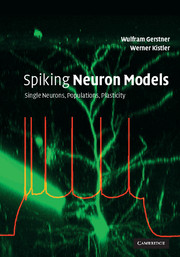12 - Plasticity and coding
Published online by Cambridge University Press: 05 June 2012
Summary
In Chapters 10 and 11 we have explored the principle of Hebbian synaptic plasticity. In this final chapter we would like to close the chain of arguments that we have followed throughout the book and establish a link between synaptic plasticity and the problems of neuronal coding and signal transmission. We will start the chapter with the question of rapid and reliable signal transmission, a question that we have encountered on several occasions in this book. In Section 12.1 we will see that an asymmetric spike-time-dependent learning rule is capable of detecting early events that may serve as predictors for others. Such a mechanism can speed up signal processing and, hence, the reaction time. In Section 12.2 we show that spike-time-dependent plasticity can enhance signal transmission by selectively strengthening synaptic connections that transmit precisely timed spikes at the expense of those synapses that transmit poorly timed spikes. In Section 12.3 we turn to sequence learning and explore whether spike-time-dependent plasticity can support coding schemes that are based on spatio-temporal spike patterns with a millisecond resolution. The last two sections study the coding properties of specific neuronal systems. In Section 12.4 we will illustrate the role of an inverted (or anti-)Hebb rule for the subtraction of expectations – which has been hypothesized as an important component of signal processing in electric fish. Finally, in Section 12.5 we will see that a spike-time-dependent Hebbian rule can play an important role in the developmental tuning of signal transmission in the auditory system of barn owls.
- Type
- Chapter
- Information
- Spiking Neuron ModelsSingle Neurons, Populations, Plasticity, pp. 421 - 454Publisher: Cambridge University PressPrint publication year: 2002



